This post may contain affiliate links. You can read my disclosure policy here.
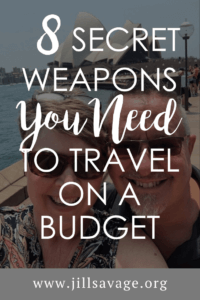 Mark and I just got back from visiting our son in Australia and we spent less than $120 each on our airfare!
Mark and I just got back from visiting our son in Australia and we spent less than $120 each on our airfare!
When Evan moved there in 2018, he was going to just stay a year, so we didn’t plan on making a visit. However, when he decided to stay longer, we knew we needed to get serious about making a trip down under.
Evan is the only one of our five grown kids who doesn’t live within thirty minutes of our home. He’s lived in Nashville, Chicago, Los Angeles, and now Australia. Because he’s always lived at a distance, we’ve made saving for travel to see him a part of our budget. When our trip to see him moved from making a trip to California and became making a trip to Australia, we knew we had to get serious about a plan for making it happen.
As full-time missionaries for the family, our annual income runs around $60,000 a year and that doesn’t leave a whole lot of extra money for a trip to Australia! We knew we’d have to be strategic about how we could make a trip happen. We also knew that if you’re going to travel somewhere that far away (it was a 33 hour trip each way counting flights and layovers), you don’t just want to stay a few days and then turn around and make that crazy long trip again just about the time you got over jet lag from the first part of it. We knew it would work best to stay a little longer, if possible. We decided we’d try for two weeks.
In order to make this trip happen, we set our sights on some specific steps that could get us there for the least amount of money. Here’s are Eight Secret Weapons we used to go to Australia for two weeks on $1900, paying just under $120 each for our flights.
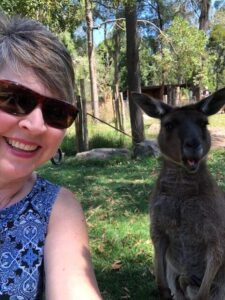 Secret Weapon #1: Automated Savings
Secret Weapon #1: Automated Savings
For years, we’ve saved $100 a month for a vacation budget. This allowed us to take a trip to Disney a year and a half ago with some of our kids and grandkids. However, that had depleted the vacation budget.
After that trip, the automated savings continued and we systematically built the savings account back up again. We’re paid every two weeks, so we have an automated transfer of $50 from our checking account to our vacation savings account set up to automatically happen the day after payday. That gives us an average savings of $100/month in our vacation fund. Over a year and a half that gave us a little over $1800 for our trip.
NOTE: We use this same strategy for more than our vacation fund. We also use it for our emergency fund, our automobile maintenance and repair fund, our home maintenance and repair fund, our property taxes, and our out-of-pocket medical expenses.
We use a local brick and mortar bank for our everyday banking, but we use an online-only bank—Ally Bank—for our savings accounts. We do this for two reasons: 1) The interest rate that Ally offers is higher, and 2) The money isn’t as easily accessible to us—it takes about two days for a transfer—so it reduces the temptation to borrow from our savings accounts on a whim.
Secret Weapon #2: Airline Miles
There’s no cost to join any of the Frequent Flier programs all the airline companies offer. If you take one trip on them, make sure you open a mileage account. We opened our first account over 25 years ago on a one-time gifted trip to Rome, Italy. That trip alone earned us enough points for a trip a year later to Puerto Rico. We didn’t travel much back then at all, but we got started accumulating miles whenever we could. It would take us 10-15 years to earn a trip, but the miles still added up and with most airlines they never expire! Now that we travel for speaking, we earn miles more often, but it still wouldn’t have been enough to get us to Australia.
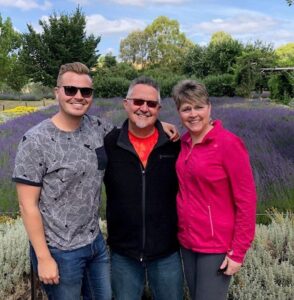
Evan and Brendan took us to a lavender farm the day before harvest. It was beautiful!
Secret Weapon #3: Delta Airlines American Express Credit Card
We’re Dave Ramsey Financial Peace graduates and we are working hard to get fully out of debt and to not take on anymore debt. However, we have found that the Delta credit card—used wisely—was key to being able to make this trip to Australia. We opened up the card two years ago and pay it off every single month. We never carry a balance past 30 days, so we’re also never charged interest.
However, every $1 we charge to the card is one airline mile on Delta. In some restaurants, we earn FOUR miles for every dollar spent. Currently you earn FIVE Miles for every dollar spent on Delta airlines purchases. Additionally, having the Delta AMEX card allows us to check one bag free for up to four people on a reservation. The card’s $99 annual fee is more than recouped with this baggage benefit. (The annual fee is waived the first year as an introductory bonus.)
When you open up an airline credit card, they usually offer a bonus of 35,000 – 70,000 miles if you spend somewhere around $3000 on the card in the first three months (this is the current Delta offer–they are currently offering 50,000 miles if you spend $3000 within 6 months!). We did that with the Delta card and earned the bonus miles. It’s really not that hard to do if you use the card for all your expenses each month—paying them off right away, of course.
We charge everything we can to this card—all our groceries, home improvement, eating out, medical expenses, and fuel. Our cell phone bill is also automatically paid with the Delta card. When we book Delta flights we currently earn 3x miles–so a $350 flight earns us 1150 miles when we buy it with the Delta AMEX card.
The key to managing expenses this way is to still stay within a predetermined budget. If you budget $600 a month for food, you have to stay within that budget no matter whether you’re paying cash for it or using a card and then paying the card off. This does require good record keeping and money management habits. I have both a spreadsheet and a spiral notebook I use just for managing money and keeping track of our expenses. Yes, it takes time, but we have more time than money so it’s worth it to me to take the time to manage it well.
We also have an American Airlines credit card for many of the same reasons—no baggage fee and accumulating miles—although we prefer Delta, so once we earned our bonus miles on the American card, we went back to primarily using the Delta card.
Putting all your eggs in one airline basket is key to more robust earning. If we have a choice of Delta or another airline and they’re pretty close in price, we’ll choose Delta every time. Same with the credit card—we generally choose to focus on earning Delta miles with our purchases.
If we lived near a Southwest Airline hub, we’d likely do the same with Southwest. I’ve heard their credit card benefits/frequent miles program are excellent and earn you easy companion passes. If you live near a Southwest hub, you might want to check it out!
Recently we took advantage of the Chase Sapphire card so we can earn United miles for our upcoming trip to Uganda. Right now you can get 60,000 bonus points with this offer.
NOTE: The AMEX card is not always accepted everywhere internationally. It was the primary card we used in Australia (yep, we were already stacking up miles for our next trip—then when we got home I took everything out of our vacation savings account and paid off the AMEX!), but we did have our Mastercard Debit Card as a back up for places that didn’t accept AMEX. And we ended up needing to carry some cash because on a few rare occasions, a place wouldn’t accept the AMEX card and our M/C debit card wouldn’t go through either. We found this happened in more remote areas than in the city, but we still had to be prepared. Oh, AND another benefit of the AMEX card is that there are no foreign transaction fees. That can save you a ton of money on a trip to another country!
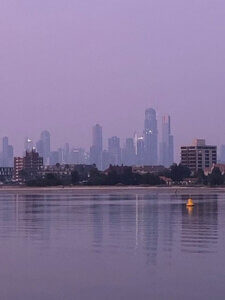
Melbourne at night. The haze is from the bushfires that are ravaging the Australian countryside.
Secret Weapon #4: Hotel Rewards
In the same way that every airline has a frequent flier program, every hotel has a reward program that’s free to join. Most hotel reward points can be transferred to airline miles. This is what ultimately allowed us to get two free flights to Australia.
A couple of years ago, I had a horrible experience at a Marriott Hotel. It was unusual and out of character for what I usually experience at a Marriott. In fact, it was a series of unfortunate events that caused me to contact their customer service to let them know of all that had happened. They were also appalled at what I experienced so, to make it right, they offered me 100,000 Marriott points. I accepted and appreciated the offer. And honestly, I forgot about it! I know…kind of crazy that I forgot about it, but I did! I earn Marriott points here and there, but not enough to add up to much so I just didn’t think about it.
When I started looking at booking flights to Australia, I was short about 25,000 points to get both of our tickets on points (it was 96,000 points for a single round trip to Sydney, Australia on the dates we booked). It looked like we were going to have to pay out of pocket for one of our flights and that was really going to cut into our limited budget. I dug around on the internet to see how else I could be earning points and ran across a blog post that mentioned exchanging Marriott points for Delta miles. That’s when the bell went off in my head! I have Marriott points!
What I learned is that hotel points to airline miles is rarely a one for one exchange. In the case of Marriott to Delta it was a three to one exchange. Three Marriott points = 1 Delta Mile. However, that’s all I needed. My 100,000 Marriott points allowed me to exchange enough for that 25,000 we needed to get both our flights on miles!
I paid a small fee to exchange the Marriott points to Delta points, a small fee to transfer some of my points to Mark’s Delta Miles account (I had more than he did so we needed to spread them out to both our accounts for us to each get a ticket with miles), and a small fee to “cash in” our Delta Miles for an actual ticket. The total of those fees made each of our tickets cost right around $120.
Secret Weapon #5: Flexible Dates
When you’re searching for flights and you have the ability to be somewhat flexible with dates, it’s very helpful to use the flexible date grid found on each airline’s website. You can use this to search for flights you’ll be buying with money or flights you want to “buy” with miles. Usually you can find this by simply clicking a box.

I did this for our trip and discovered that flying on New Year’s Eve and returning a week or two later on a Thursday required the least number of miles within the two month period of December and January. There were some dates we didn’t have enough miles for, but if we left on New Year’s Eve—we had enough miles for that! So New Year’s Eve it was! We left the USA at 10pm on New Year’s Eve and arrived in Australia on the morning of January 2—completely missing out on New Year’s Day 2020! (Australia is 17 hours ahead of Central Standard Time!) However, we were where we wanted to be, and we got there in the least expensive way we could!
Here’s what it looks like for flexible dates in money.

Here’s what it looks like for flexible dates in miles.
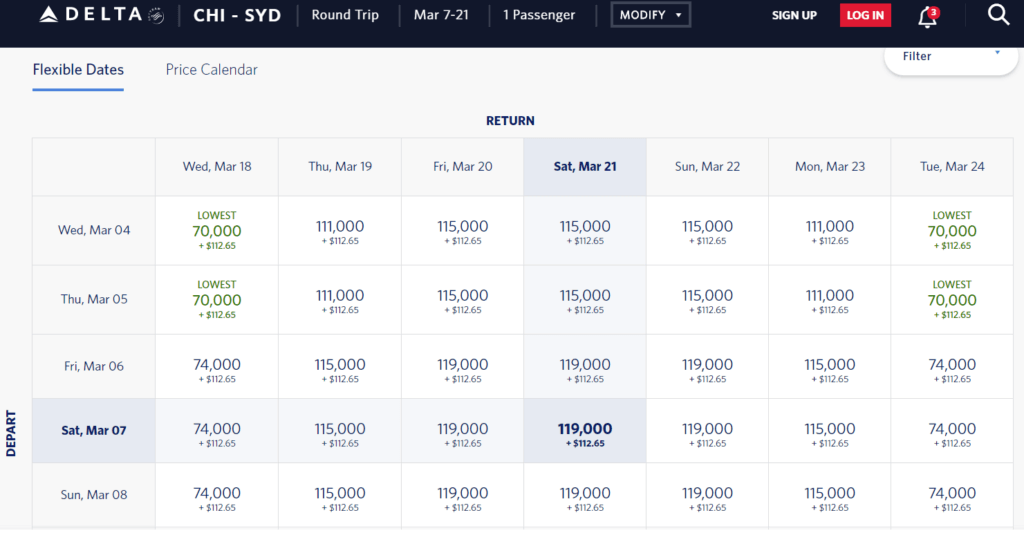
Secret Weapon #6: Airbnb and Home Exchange
I’ve shared before of our love for Airbnb. We’ve been using it for travel for the past four years and we hosted Airbnb for three years. We find it affordable and often allows us to have accommodations with a kitchen so we can cook for ourselves. This is helpful for healthy eating and saving money.
We spent four days in Sydney before traveling to Evan’s in Melbourne, so we found a cute little Airbnb with great reviews for those three nights. It was $61/night. Once we were in Melbourne, we stayed with Evan and Brendan for a week, but decided to get an Airbnb for the last four nights. We paid $47/night for a cute little studio apartment just a few blocks away.
We’ve also started using Airbnb Experiences when we’re traveling. Airbnb experiences are tours, experiences, or services offered by locals. When we traveled to Austria and Hungary to speak at four marriage events and one mom conference in the Spring, we did an Airbnb experience that a local professional photographer offered. For a small fee he took pics of Mark and I for an hour in Vienna. Those are pics we treasure and share occasionally on social media.
On this trip to Australia, we did an Airbnb experience that took us on a mountain tour. There were just four of us on the tour. It was small, private, and personalized. We loved getting to know our tour guide, Michael, and he loved showing us a part of Australia he loves. The cost of the tour was less than the big bus tours and definitely more personalized.
UPDATE 2022: We’re making our second trip to Australia and this time we’re using Home Exchange. You can do reciprocal or non-reciprocal home exchanges. In our case, we set up our home on Home Exchange which earned us 1200 points on the platform. We then found a home in Melbourne Australia that was willing to do an exchange for points. The only thing we had to pay for was the annual Home Exchange fee of $175. Therefore, it cost us just $175 for 12 days of housing in our son’s neighborhood!
NOTE: Reviews are key to using Airbnb stays or experiences. We spend time reading the reviews before we book anything.
Secret Weapon #7: Public Transportation
When you live in the country like we do, you don’t take public transportation anywhere because it’s simply not available. However, when traveling it can save you a ton of money. We used trains and buses in Sydney and trains and trams in Melbourne. There’s a learning curve for sure, but once you learn how it works—it’s a great way to navigate around.
Google Maps is a lifesaver with public transportation. Just type in the address or the name of your destination. It will give you the option of walking, driving, or public transportation. If you click on the public transportation symbol, it will tell you exactly what to do to get where you need to go.
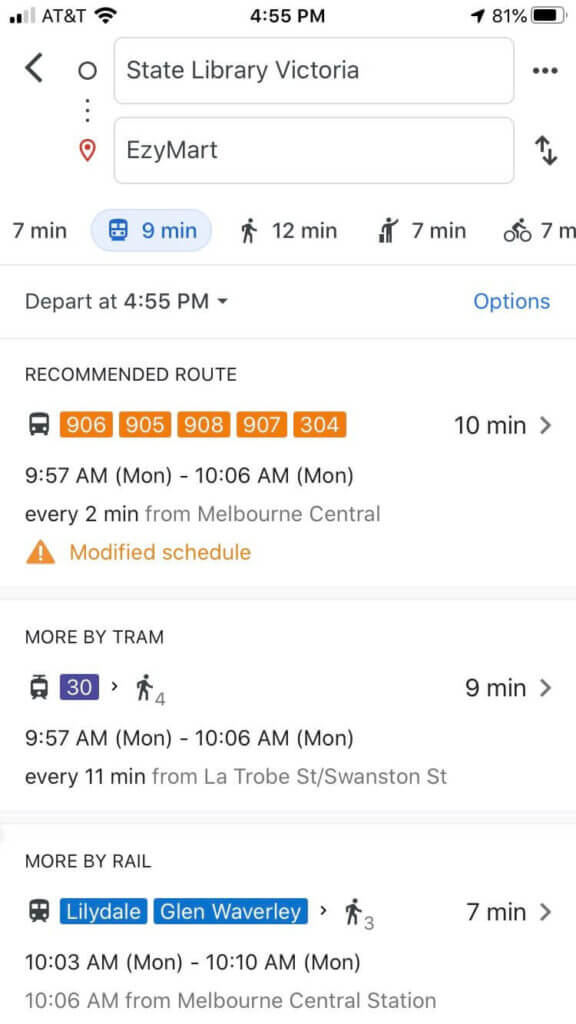
We also used Uber in Australia. There were no buses to get us to the airport at 4am for our trip home and Evan had to work that day so an Uber or taxi was our only option. We love Uber because it all done on the phone—there’s no exchange of money in the car. In the states we use both Uber and Lyft if needed. Both have some reward and referral programs where we can earn free rides.
- Here’s a code you can use for $2 off each of your first three Uber rides: jills9048ue.
- Here’s a code you can use for $5 in ride credit from Lyft: JILL122710
Of course, you need to expect some mishaps. We nearly missed our bus stop in Sydney because we hadn’t yet learned that the “stop” buttons at each seat were not for emergency use but rather to tell the driver to stop at your bus stop. If no one is waiting at the stop and no one requests it, they drive right on by!
We also got on a tram in Melbourne and it took us in the wrong direction than we needed to go. We ended up at the beach instead of the market we were headed to, so we took advantage of the unexpected detour, got off and watched windsurfers for 10 minutes, and then got on the right tram that took us in the right direction! You have to have a sense of humor and a heart of exploration to successfully learn public transport in a new city, but it’s a great, affordable way to get around (and to feel more like a local!)
Secret Weapon #8: Manage Meal Expenses
When traveling, meals can be one of the most expensive parts of a trip. We use four strategies to save money on meals:
- Two meals a day instead of three. When we’re on vacation, we sometimes sleep late allowing us to eat brunch around 11am and then dinner around 5pm, sometimes with a hearty snack in between.
- Share meals. Many restaurants give ample size servings that allow you to share a meal and still be plenty full. Mark and I often share a meal when we eat out at home, and we do the same when we’re on vacation.
- Drink water. Alcohol and soft drinks add quite a bit to meal costs when you’re eating more meals out than usual. This was an absolute when our kids were at home and we were traveling with seven of us! Water for everyone!
- Prepare your own meals. If you have a kitchen in your accommodations–use it! If you can make sandwiches and carry them in a cooler or backpack, do it! We made several trips to the grocery store and ate quite a few meals in our own place saving us several hundred dollars over the two-week travel period.
Of course, there are sometimes when you just want to eat out and enjoy it. If your budget allows for it, by all means, enjoy!
*************
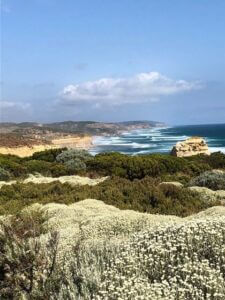 We loved our time in Australia and getting to see our son in his world. We also loved getting away for a longer trip than we’d ever taken before. We fed kangaroos, hiked the Blue Mountains, drove the Great Ocean Road, ate fantastic food, and explored a lavender farm. If you’d like to see some of the best pictures from our trip, you can find it on my Instagram highlights titled “Australia.”
We loved our time in Australia and getting to see our son in his world. We also loved getting away for a longer trip than we’d ever taken before. We fed kangaroos, hiked the Blue Mountains, drove the Great Ocean Road, ate fantastic food, and explored a lavender farm. If you’d like to see some of the best pictures from our trip, you can find it on my Instagram highlights titled “Australia.”
Oh and if you’ve learned to travel for less, I’d love to know what secret weapons you use! Leave them in the comments below!
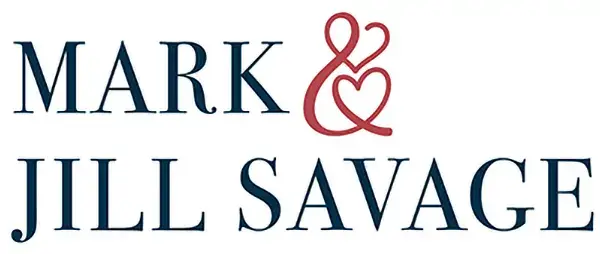
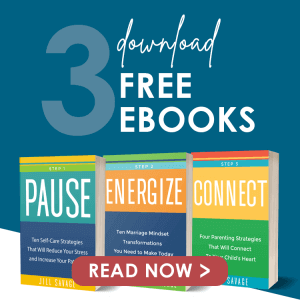

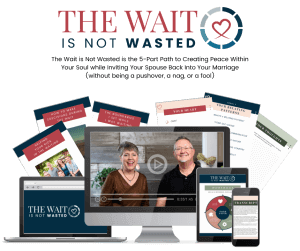
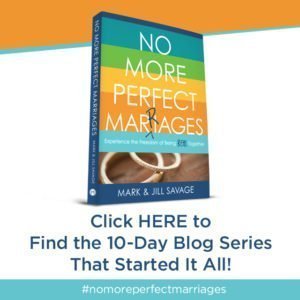







At least in the U.K. supermarket points can be converted into airline miles and with some airlines miles can be used to pay for hotel rooms as well as the flights. Having set my main supermarket card up to do this then forgotten about it I discovered after a few years we had enough for flights and a weeks bed and breakfast in a nice hotel.
Day trips out can also be paid for either entirely or partially with supermarket points or alternatively if you travel by train to an attraction you can often get 2 for 1 entry (this is useful for visitors to the U.K.). You need to visit a website (search 2 for 1 trains) in advance and download a voucher – you then show that with your train ticket for the discount at the door
That’s a great benefit you have in the UK! Thanks for the insight for UK visitors. Mark and I hope to return there sometime.
I love all of this and we use many of the same strategies. I spent very little on my trip to Switzerland. Also if you are involved in ministry sometimes you can stay at a YWAM base. I also try to fly through another country with the 23 hour stay rule so I can see that location as well both coming and going with the same amount of miles. Finally one last tip as I usually look for the things I want to do in the states especially on Groupon. I got the same tour for half price that way.
Great suggestions, Michelle! What is the 23-hour stay rule?
Anything over 23 hours is considered a layover and companies can charge you more for the ticket. 23 hours and 59 minutes isn’t, so you can leave the airport and go explore the city for the day and then comeback and hop on your next flight. ? A cheaper way to see a city without more expense. You just have to have the additional travel time.
My intermittent fasting lifestyle saved a ton of money while traveling for three weeks in Ireland 🙂
Love that! I guess that’s what we did without even realizing it!
When traveling within the United States, I look on Groupon to see if I can get BOGO coupons for food and attractions. I also look on TripAdvisor to read reviews, it has offered some great insight on off the beaten track excursions at a lot less cost than big companies!
Jill, I heard you talk about some of these strategies on your year end podcast. Thank you! But I am trying to click on the links mentioned (specifically for the Delta cards) and nothing is coming up. Do you have updated 2023 links?
Allison, I didn’t realize the link didn’t work. I’ve updated the post! Here’s the correct one: https://americanexpress.com/en-us/referral/JILLSIoqj?xl=cp19